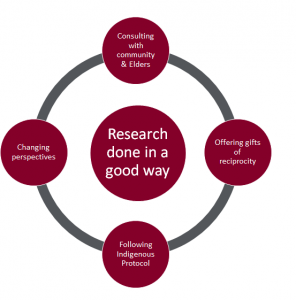Protocols
When researchers write about work done with Indigenous communities, they should explicitly state any Indigenous Protocols they followed.

Research done in a good way often includes one or more of the following:
-
- Consulting with community and Elders
- Offering gifts of reciprocity
- Following Indigenous Protocols
- Changing perspectives
The article Tobacco Ties also provides an excellent example of Indigenous research practice done in a good way.
“We were never able to get to these big questions; we realized we had to slow right down tot he first step: respecting tobacco. We had agreed that when approaching Elders, tobacco would be offered. As we engaged in conversation, much of what the Elders’ teachings centered on the use of tobacco as protocol. The present article reflects this change of focus.” ( Wilson & Restoule, 2010, p. 34)
These researchers changed the perspective of their research after following the protocol of reciprocity in offering tobacco when consulting with Elders.
For research that is less cultural in nature, researchers may not explicitly state which Protocols they are following; however, they should always discuss how they approached their work in a good way by either consulting with community, consulting with Elders, or offering gifts of reciprocity. Reciprocity may take may forms. One of the most widely known Indigenous forms of reciprocity is the giving of tobacco to knowledge holders (Wilson & Restoule, 2010). Other forms of reciprocity may include the giving of gifts, such as home made jams, bead work, or harvest items to research participants. Initiating a discussion to determine the prefered form of reciprocity is part of relationship building. Reciprocity may also include financial compensation, but typically financial compensation is seen more as a transaction. Transactions are one-time events; where as reciprocal exchange through gift giving evokes a relationship between the giver and the receiver. Financial compensation is common when non-Indigenous parties request time and expertise from Indigenous community members. Even when financial compensation is offered, it is ideal to present this along with a gift of reciprocity.


